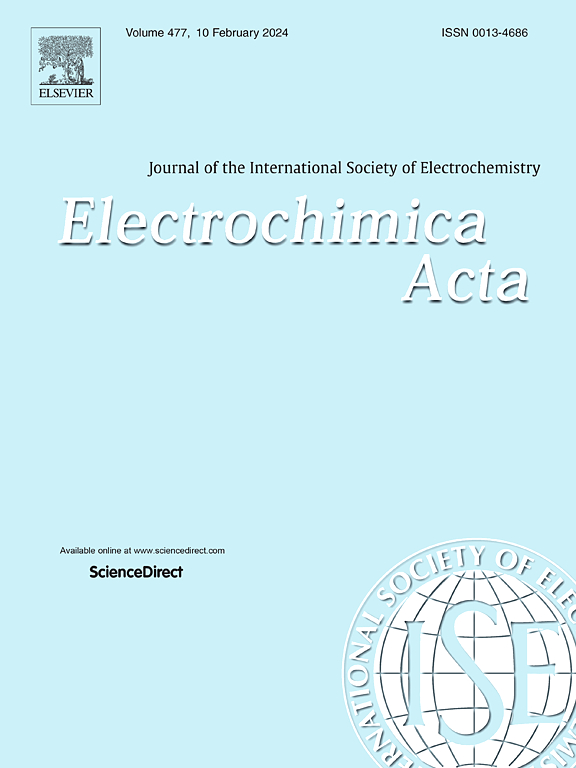增强掺硼氧化钴纳米粒子的电化学活性,促进超级电容器的应用
IF 5.5
3区 材料科学
Q1 ELECTROCHEMISTRY
引用次数: 0
摘要
通过在氧化钴纳米粒子的晶体结构表面掺杂金属/非金属/类金属,有望制造出具有优异电化学性能的电活性超级电容器。在此,我们通过简便的共沉淀路线制备了掺硼的氧化钴纳米粒子(B@Co3O4),并将其应用于超级电容器。在氧化钴纳米粒子(3M B@Co3O4)中掺入硼后,比表面积(548.126 m2g-1)增加了 4.2 倍,带隙能降低,晶体尺寸减小。因此,在 1M KOH 电解质溶液中,当电流密度为 1.5mA/cm2、扫描速率为 2mV/s 时,掺杂了 B 的 Co3O4 NPs 显示出 998.12 F/g 的最大比电容,与原始 Co3O4 NPs 的 668.79 F/g 相比增加了 1.50 倍。此外,3M B@Co3O4 NPs 的功率密度为 711.14W/kg,能量密度高达 195.96Wh/kg。因此,我们认为掺硼氧化钴纳米粒子是一种很有前途的超级电容器应用电活性材料。本文章由计算机程序翻译,如有差异,请以英文原文为准。


Enhanced electrochemical activity of boron doped cobalt oxide nanoparticles towards supercapacitor application
Doping via metal/nonmetal/metalloid dopants in to the crystal structural surface of cobalt oxide nanoparticles are promising for creating electroactive supercapacitors with excellent electrochemical performance. Herein, we fabricate boron doped cobalt oxide nanoparticles (B@Co3O4) via a facile co-precipitation route for supercapacitor applications. The incorporation of boron into cobalt oxide nanoparticles (3M B@Co3O4) brings a ∼4.2-fold increase in a specific surface area (548.126 m2g-1), decrease in band gap energy and reduced in crystalline size. Consequently, the B doped Co3O4 NPs displays a maximum specific capacitance of 998.12 F/g, which is ∼1.50-fold increased as compared to 668.79 F/g of the pristine Co3O4 NPs at current density 1.5mA/cm2 and scan rate 2mV/s in 1 M KOH electrolyte solution. Moreover, 3 M B@Co3O4 NPs demonstrates excellent power density 711.14W/kg and high energy density 195.96Wh/kg Wh/kg. Hence, we believe that boron doped cobalt oxide nanoparticles are a promising electroactive material for the supercapacitive applications.
求助全文
通过发布文献求助,成功后即可免费获取论文全文。
去求助
来源期刊

Electrochimica Acta
工程技术-电化学
CiteScore
11.30
自引率
6.10%
发文量
1634
审稿时长
41 days
期刊介绍:
Electrochimica Acta is an international journal. It is intended for the publication of both original work and reviews in the field of electrochemistry. Electrochemistry should be interpreted to mean any of the research fields covered by the Divisions of the International Society of Electrochemistry listed below, as well as emerging scientific domains covered by ISE New Topics Committee.
 求助内容:
求助内容: 应助结果提醒方式:
应助结果提醒方式:


